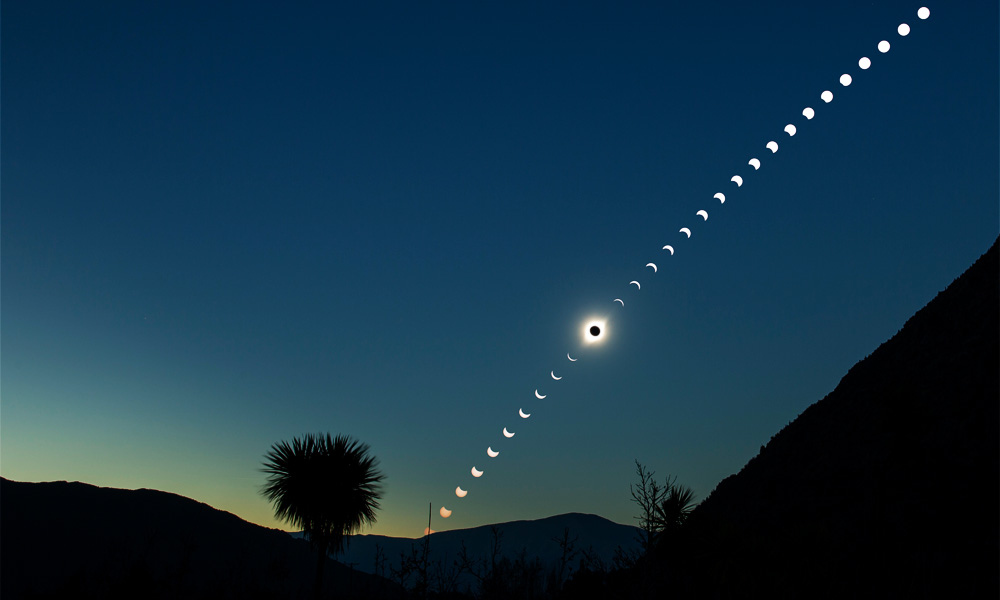
On April 8, 2024, a total solar eclipse will pass through parts of Mexico, the United States and Canada. This will be the first total solar eclipse in these parts since 2017, when 21 million people in the U.S. traveled to see it. (The next one will be 20 years from now, in 2044.)
A total solar eclipse lasts between 2.5 to 4.5 minutes. During that time, the Earth will turn as dark as at nighttime. Animals will be deeply disturbed. It will be preceded by an hour when the moon will begin to cover the sun and then an hour more as the moon passes by. Viewers are urged to wear specialized eclipse glasses, which can be purchased for a few dollars: looking directly at the sun (except at the moment of total eclipse) can seriously damage your eyes.
What did our Jewish ancestors experience?
Solar Eclipse in the Hebrew Bible
In biblical times, human societies were frightened and overwhelmed by eclipses, thinking that some great and unknown force, such as God or an evil spirit, was at work. For ancient Israelites, God created the sun and moon, set them in the sky, and “separated light from darkness” on the fourth day of creation (Gen.1:14-19). Therefore, only God could interrupt their normal expected cycles, and a solar eclipse—a very, very unusual event—was a cause for alarm and fear.
The prophet Amos in particular saw the solar eclipse as an omen of punishment to the Israelites for disregarding their ethical responsibilities—especially to help the needy and the poor. He wrote, “Shall not the earth shake for this?…On that day, declares God, I will make the sun set at noon, I will darken the earth on a sunny day.” (Amos 8:8-9). Similarly, Jeremiah describes portents in the sky (Jeremiah 10:2) and Isaiah describes the “Day of Adonai” that is coming with God’s wrath that “the sun shall be dark when it rises, and the moon shall diffuse no glow.” (Is. 13:9-10) . These biblical authors clearly saw eclipses as terrifying interruptions in the natural order.
Amos was active in the northern kingdom of Israel during the reign of Jeroboam II (c. 786–746 BCE). As reported by Rabbi Tzvi Pittinsky, Amos could well have been responding to a real eclipse which, according to NASA, occurred in 763 BCE in Assyria and is called the “Assyrian Eclipse.” One ancient Assyrian chronology written about that time reports that “in Simanu, there was an eclipse of the sun.” NASA reports that the totality of the eclipse occurred over Nineveh (near the current city of Mosul). It is estimated that at the same time there would have been about a 90 percent coverage in northern Israel.


Solar Eclipse in the Talmud
Consistently in the Talmud, a solar eclipse is considered a bad omen for humanity. We read, “The Sages taught: When the sun is eclipsed, it is a bad omen for the entire world,” (Sukkah 29a). A parable follows: A king was angry at his subjects. He invited them to a feast, placed lanterns in the hall, and then removed the lanterns and forced them to sit in darkness.
Earlier in the same section in the Talmud, Rabbi Meir (2nd century CE) is quoted as saying: “When the heavenly lights, the sun and the moon, are eclipsed, it is a bad omen for the enemies of the Jewish people.” But he also says it is a bad omen for the Jewish people. Later commentators on this section assumed that any calamity that afflicts the world is directed at the Jews, since “we are the targets of many beatings.” Others note that a solar eclipse must be a bad omen for other nations in general, since their calendar follows the rotation of the sun. A lunar eclipse, on the other hand, is directed to the enemies of the Jewish people, since our calendar is based on the cycle of the moon. The location of the eclipse, the color of the sky, and the time of day of the eclipse foretell for whom the eclipse is a bad omen.
In another section, the ancient rabbis speculated that the causes of the eclipse could include “disregard for the honor of a rabbi following his death, ignoring the cries of an engaged woman being attacked, the forgery of documents, and people who brought false testimony to court, among several other sins.” Of these explanations, Rashi wrote, “I do not know of an explanation for this.” But it is likely that these particular sins were considered important by the rabbis.
Later Jewish understandings of the solar eclipse
In the beginning of the modern era, rabbinic authorities noted that if solar eclipses were precisely predictable, then they could not be caused by the misdeeds of people. According to Dr. Jeremy Brown, 17th and 18th century thinkers such as the Maharal of Prague, Rabbi Yonason Eibschutz, and Rabbi David Pardo, as well as later thinkers such as Rabbi Menachem Mendel Schneerson, the Lubavitcher Rebbe in the latter half of the 20th century, all grappled with the conflict between the predictability of solar eclipses and the Talmudic connection to human misdeeds.
Rabbi Schneerson wrote in 1957 about the contradiction between the Talmud and meteorology. He said that it was true that a solar eclipse was predictable, but local weather was not, suggesting that God could be responding to the actions of people on a daily basis. In any event, Orthodox religious leaders and thinkers continue to insist that a solar eclipse, at the least, should animate scholars to study more deeply.
Today’s Beliefs and Experiences
Even for secular humans, a solar eclipse can be an awe-inspiring event and help us realize how small we are in comparison to the vastness of nature. Events such as these also can help us connect more deeply with the people around us. One recent study, which analyzed the responses of 2.8 million Twitter users to the 2017 eclipse, found that people in the path of totality “had increases in awe and social processes that are core to collective life. They had less self-focus and greater prosociality, affiliation, collective focus, and humility than those who had not seen the eclipse.”
Rachel Lanman, a scientist and the leader of a summer program exploring Israel through the lens of science and technology, says that we can see the eclipse as a reminder of the importance and value of the sun, as well as to be thankful for the light. She says we should use the eclipse as an opportunity to ask questions about the earth, marvel at its natural wonders and appreciate the daily miracle. As Abraham Joshua Herschel said, we must sense nature as mystery and grandeur.
The route of the eclipse
A chart on NASA’s website shows the path of the April 8 solar eclipse, starting in Mexico, then passing through Texas, Arkansas, Missouri, Ohio, lower Quebec, upstate New York, northern Maine, and New Brunswick in Canada. It will go directly over Indianapolis, Cleveland, and Dallas. For those who want to find a good place to view the eclipse, be aware that cloudy days are problematic. Mexico and Texas will have the highest proportion of clear skies. Cleveland and Indianapolis will have a 60 percent chance of clouds.
It may be a long way to Cleveland, Dallas, or Mexico, but it is worth trying to experience the rare event of a total solar eclipse. A solar eclipse is a time for joy, for sharing a moving experience with our friends and children, for marveling at the natural wonders, and for deepening our understanding of humankind’s place in the universe. If you go, it will touch you profoundly.
Laurence Wolff is a senior editor of Moment magazine and formerly worked for the World Bank and other international agencies as an Education Development specialist. Rabbi Fred Reiner is Rabbi Emeritus of Temple Sinai in Washington, DC and serves on the faculty of the Wesley Theological Seminary in Washington, DC.
Top image: A time-lapse photo of the 2019 total solar eclipse taken at El Molle, Chile. (Photo credit: Callan Carpenter / CC BY-SA 4.0).
